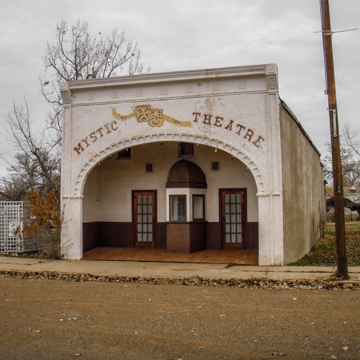The Mystic Theater was unusual among early North Dakota theaters because it was specifically intended for showing motion pictures. In 1914, one of the new settlers to Marmarth was Guy Johnson, a Nebraska-born professional baseball pitcher. Within two months, the diminutive Mystic Theater, measuring just 26 x 76 feet was dedicated. The stucco-clad facade features an elaborate galvanized-metal cornice with egg-and-dart and bead-and-reel moldings, paterae, and enriched consoles. The archivolt of the entrance arch is marked with fret banding, and the soffit is illuminated with a string of multicolored lights. From the lobby, enclosed quarter-turn stairways lead to a balcony that seats 20 people. The balcony has a curved railing with gilt-painted wooden balusters suspended from metal rods. The auditorium could seat 187 people. Even with the community’s dwindling population, the theater made the transition to sound movies in 1930, but it closed in the 1950s. In 1976, the Marmarth Historical Society restored and reopened the Mystic as a “working museum” serving a variety of local uses including public entertainment and town meetings.
You are here
Mystic Theater
If SAH Archipedia has been useful to you, please consider supporting it.
SAH Archipedia tells the story of the United States through its buildings, landscapes, and cities. This freely available resource empowers the public with authoritative knowledge that deepens their understanding and appreciation of the built environment. But the Society of Architectural Historians, which created SAH Archipedia with University of Virginia Press, needs your support to maintain the high-caliber research, writing, photography, cartography, editing, design, and programming that make SAH Archipedia a trusted online resource available to all who value the history of place, heritage tourism, and learning.















